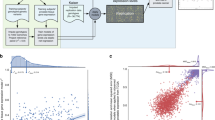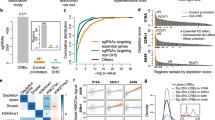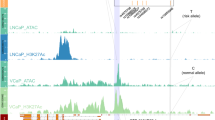Abstract
Molecular characterization of genome-wide association study (GWAS) loci can uncover key genes and biological mechanisms underpinning complex traits and diseases. Here we present deep, high-throughput characterization of gene regulatory mechanisms underlying prostate cancer risk loci. Our methodology integrates data from 295 prostate cancer chromatin immunoprecipitation and sequencing experiments with genotype and gene expression data from 602 prostate tumor samples. The analysis identifies new gene regulatory mechanisms affected by risk locus SNPs, including widespread disruption of ternary androgen receptor (AR)-FOXA1 and AR-HOXB13 complexes and competitive binding mechanisms. We identify 57 expression quantitative trait loci at 35 risk loci, which we validate through analysis of allele-specific expression. We further validate predicted regulatory SNPs and target genes in prostate cancer cell line models. Finally, our integrated analysis can be accessed through an interactive visualization tool. This analysis elucidates how genome sequence variation affects disease predisposition via gene regulatory mechanisms and identifies relevant genes for downstream biomarker and drug development.
This is a preview of subscription content, access via your institution
Access options
Subscribe to this journal
Receive 12 print issues and online access
$209.00 per year
only $17.42 per issue
Buy this article
- Purchase on Springer Link
- Instant access to full article PDF
Prices may be subject to local taxes which are calculated during checkout






Similar content being viewed by others
References
Hindorff, L.A. et al. Potential etiologic and functional implications of genome-wide association loci for human diseases and traits. Proc. Natl. Acad. Sci. USA 106, 9362–9367 (2009).
Maurano, M.T. et al. Systematic localization of common disease-associated variation in regulatory DNA. Science 337, 1190–1195 (2012).
Schaub, M.A., Boyle, A.P., Kundaje, A., Batzoglou, S. & Snyder, M. Linking disease associations with regulatory information in the human genome. Genome Res. 22, 1748–1759 (2012).
Spitz, F. & Furlong, E.E.M. Transcription factors: from enhancer binding to developmental control. Nat. Rev. Genet. 13, 613–626 (2012).
Panne, D., Maniatis, T. & Harrison, S.C. An atomic model of the interferon-β enhanceosome. Cell 129, 1111–1123 (2007).
Arnosti, D.N., Barolo, S., Levine, M. & Small, S. The eve stripe 2 enhancer employs multiple modes of transcriptional synergy. Development 122, 205–214 (1996).
Thurman, R.E. et al. The accessible chromatin landscape of the human genome. Nature 489, 75–82 (2012).
Johnson, D.S., Mortazavi, A., Myers, R.M. & Wold, B. Genome-wide mapping of in vivo protein-DNA interactions. Science 316, 1497–1502 (2007).
Whitington, T., Frith, M.C., Johnson, J. & Bailey, T.L. Inferring transcription factor complexes from ChIP-seq data. Nucleic Acids Res. 39, e98 (2011).
Jankowski, A., Szczurek, E., Jauch, R., Tiuryn, J. & Prabhakar, S. Comprehensive prediction in 78 human cell lines reveals rigidity and compactness of transcription factor dimers. Genome Res. 23, 1307–1318 (2013).
Smith, R.P. et al. Massively parallel decoding of mammalian regulatory sequences supports a flexible organizational model. Nat. Genet. 45, 1021–1028 (2013).
Al Olama, A.A. et al. A meta-analysis of 87,040 individuals identifies 23 new susceptibility loci for prostate cancer. Nat. Genet. 46, 1103–1109 (2014).
Huang, Q. et al. A prostate cancer susceptibility allele at 6q22 increases RFX6 expression by modulating HOXB13 chromatin binding. Nat. Genet. 46, 126–135 (2014).
Zhang, X., Cowper-Sallari, R., Bailey, S.D., Moore, J.H. & Lupien, M. Integrative functional genomics identifies an enhancer looping to the SOX9 gene disrupted by the 17q24.3 prostate cancer risk locus. Genome Res. 22, 1437–1446 (2012).
Grisanzio, C. et al. Genetic and functional analyses implicate the NUDT11, HNF1B, and SLC22A3 genes in prostate cancer pathogenesis. Proc. Natl. Acad. Sci. USA 109, 11252–11257 (2012).
Xu, X. et al. Variants at IRX4 as prostate cancer expression quantitative trait loci. Eur. J. Hum. Genet. 22, 558–563 (2014).
Li, Q. et al. Expression QTL–based analyses reveal candidate causal genes and loci across five tumor types. Hum. Mol. Genet. 23, 5294–5302 (2014).
Penney, K.L. et al. Association of prostate cancer risk variants with gene expression in normal and tumor tissue. Cancer Epidemiol. Biomarkers Prev. 24, 255–260 (2015).
Hazelett, D.J. et al. Comprehensive functional annotation of 77 prostate cancer risk loci. PLoS Genet. 10, e1004102 (2014).
Jia, L. et al. Functional enhancers at the gene-poor 8q24 cancer-linked locus. PLoS Genet. 5, e1000597 (2009).
Liu, T. et al. Cistrome: an integrative platform for transcriptional regulation studies. Genome Biol. 12, R83 (2011).
Wu, D. et al. Three-tiered role of the pioneer factor GATA2 in promoting androgen-dependent gene expression in prostate cancer. Nucleic Acids Res. 42, 3607–3622 (2014).
Battle, A. et al. Characterizing the genetic basis of transcriptome diversity through RNA-sequencing of 922 individuals. Genome Res. 24, 14–24 (2014).
Reich, M. et al. GenePattern 2.0. Nat. Genet. 38, 500–501 (2006).
Gene Ontology Consortium. Gene Ontology Consortium: going forward. Nucleic Acids Res. 43, D1049–D1056 (2015).
Pickrell, J.K. et al. Understanding mechanisms underlying human gene expression variation with RNA sequencing. Nature 464, 768–772 (2010).
Dixon, J.R. et al. Topological domains in mammalian genomes identified by analysis of chromatin interactions. Nature 485, 376–380 (2012).
Cingolani, P. et al. A program for annotating and predicting the effects of single nucleotide polymorphisms, SnpEff: SNPs in the genome of Drosophila melanogaster strain w1118; iso-2; iso-3. Fly (Austin) 6, 80–92 (2012).
Mills, I.G. Maintaining and reprogramming genomic androgen receptor activity in prostate cancer. Nat. Rev. Cancer 14, 187–198 (2014).
Norris, J.D. et al. The homeodomain protein HOXB13 regulates the cellular response to androgens. Mol. Cell 36, 405–416 (2009).
Pomerantz, M.M. et al. The androgen receptor cistrome is extensively reprogrammed in human prostate tumorigenesis. Nat. Genet. 47, 1346–1351 (2015).
Jin, H.-J., Zhao, J.C., Wu, L., Kim, J. & Yu, J. Cooperativity and equilibrium with FOXA1 define the androgen receptor transcriptional program. Nat. Commun. 5, 3972 (2014).
Melton, C., Reuter, J.A., Spacek, D.V. & Snyder, M. Recurrent somatic mutations in regulatory regions of human cancer genomes. Nat. Genet. 47, 710–716 (2015).
Tomlins, S.A. et al. Recurrent fusion of TMPRSS2 and ETS transcription factor genes in prostate cancer. Science 310, 644–648 (2005).
Nguyen, H.H. et al. IRX4 at 5p15 suppresses prostate cancer growth through the interaction with vitamin D receptor, conferring prostate cancer susceptibility. Hum. Mol. Genet. 21, 2076–2085 (2012).
Bauer, D.E. et al. An erythroid enhancer of BCL11A subject to genetic variation determines fetal hemoglobin level. Science 342, 253–257 (2013).
Boyle, A.P. et al. Annotation of functional variation in personal genomes using RegulomeDB. Genome Res. 22, 1790–1797 (2012).
Zhou, Y., Bolton, E.C. & Jones, J.O. Androgens and androgen receptor signaling in prostate tumorigenesis. J. Mol. Endocrinol. 54, R15–R29 (2015).
Tuupanen, S. et al. The common colorectal cancer predisposition SNP rs6983267 at chromosome 8q24 confers potential to enhanced Wnt signaling. Nat. Genet. 41, 885–890 (2009).
Feng, J. et al. A genome-wide survey over the ChIP-on-chip identified androgen receptor–binding genomic regions identifies a novel prostate cancer susceptibility locus at 12q13.13. Cancer Epidemiol. Biomarkers Prev. 20, 2396–2403 (2011).
Hazelett, D.J., Coetzee, S.G. & Coetzee, G.A. A rare variant, which destroys a FoxA1 site at 8q24, is associated with prostate cancer risk. Cell Cycle 12, 379–380 (2013).
Zaret, K.S. & Carroll, J.S. Pioneer transcription factors: establishing competence for gene expression. Genes Dev. 25, 2227–2241 (2011).
Pedersen, S.F. & Stock, C. Ion channels and transporters in cancer: pathophysiology, regulation, and clinical potential. Cancer Res. 73, 1658–1661 (2013).
Yokoyama, Y. et al. Matrilysin (MMP-7) is a novel broadly expressed tumor antigen recognized by antigen-specific T cells. Clin. Cancer Res. 14, 5503–5511 (2008).
Szarvas, T. et al. Elevated serum matrix metalloproteinase 7 levels predict poor prognosis after radical prostatectomy. Int. J. Cancer 128, 1486–1492 (2011).
Moll, R., Divo, M. & Langbein, L. The human keratins: biology and pathology. Histochem. Cell Biol. 129, 705–733 (2008).
Howie, B.N., Donnelly, P. & Marchini, J. A flexible and accurate genotype imputation method for the next generation of genome-wide association studies. PLoS Genet. 5, e1000529 (2009).
Shabalin, A.A. Matrix eQTL: ultra fast eQTL analysis via large matrix operations. Bioinformatics 28, 1353–1358 (2012).
Price, A.L. et al. Principal components analysis corrects for stratification in genome-wide association studies. Nat. Genet. 38, 904–909 (2006).
Jiang, H., Lei, R., Ding, S.-W. & Zhu, S. Skewer: a fast and accurate adapter trimmer for next-generation sequencing paired-end reads. BMC Bioinformatics 15, 182 (2014).
Dobin, A. et al. STAR: ultrafast universal RNA-seq aligner. Bioinformatics 29, 15–21 (2013).
Li, H. & Durbin, R. Fast and accurate short read alignment with Burrows-Wheeler transform. Bioinformatics 25, 1754–1760 (2009).
Zhang, Y. et al. Model-based analysis of ChIP-Seq (MACS). Genome Biol. 9, R137 (2008).
Hartmann, H., Guthöhrlein, E.W., Siebert, M., Luehr, S. & Söding, J. P-value–based regulatory motif discovery using positional weight matrices. Genome Res. 23, 181–194 (2013).
Bryne, J.C. et al. JASPAR, the open access database of transcription factor–binding profiles: new content and tools in the 2008 update. Nucleic Acids Res. 36, D102–D106 (2008).
Newburger, D.E. & Bulyk, M.L. UniPROBE: an online database of protein binding microarray data on protein-DNA interactions. Nucleic Acids Res. 37, D77–D82 (2009).
Jolma, A. et al. DNA-binding specificities of human transcription factors. Cell 152, 327–339 (2013).
Sonnhammer, E.L., Eddy, S.R., Birney, E., Bateman, A. & Durbin, R. Pfam: multiple sequence alignments and HMM-profiles of protein domains. Nucleic Acids Res. 26, 320–322 (1998).
Grant, C.E., Bailey, T.L. & Noble, W.S. FIMO: scanning for occurrences of a given motif. Bioinformatics 27, 1017–1018 (2011).
Siepel, A. et al. Evolutionarily conserved elements in vertebrate, insect, worm, and yeast genomes. Genome Res. 15, 1034–1050 (2005).
Robinson, J.T. et al. Integrative genomics viewer. Nat. Biotechnol. 29, 24–26 (2011).
Warren, A.Y. et al. Method for sampling tissue for research which preserves pathological data in radical prostatectomy. Prostate 73, 194–202 (2013).
Lindberg, J. et al. Exome sequencing of prostate cancer supports the hypothesis of independent tumour origins. Eur. Urol. 63, 347–353 (2013).
Ross-Adams, H. et al. Integration of copy number and transcriptomics provides risk stratification in prostate cancer: a discovery and validation cohort study. EBioMedicine 2, 1133–1144 (2015).
Dunning, M.J., Smith, M.L., Ritchie, M.E. & Tavaré, S. beadarray: R classes and methods for Illumina bead-based data. Bioinformatics 23, 2183–2184 (2007).
Eeles, R.A. et al. Identification of 23 new prostate cancer susceptibility loci using the iCOGS custom genotyping array. Nat. Genet. 45, 385–391 e1–e2 (2013).
Acknowledgements
We thank the authors of all the ChIP-seq data used in this study; a full listing of the original publications and corresponding accession codes is provided in Supplementary Table 1. We acknowledge the ENCODE Consortium and the Stamatoyannopoulos laboratory for generating the DNase-seq data considered here. The RNA-seq data analyzed here were generated by the TCGA Research Network (see URLs). Computations were performed using resources provided by the Swedish National Infrastructure for Computing (SNIC), through the Uppsala Multidisciplinary Center for Advanced Computational Science (UPPMAX) under project b2013051. We acknowledge the National Cancer Research Institute (National Institute of Health Research (NIHR)) collaborative study Prostate Cancer: Mechanisms of Progression and Treatment (ProMPT) collaborative (grant G0500966/75466) (see URLs) and the Addenbrooke's Hospital Human Research Tissue bank, NIHR Cambridge Biomedical Research Centre, which funded tissue collections in Cambridge. This work was funded by a Cancer Research UK program grant, C5047/A14835, awarded to D.E.N., Swedish Cancer Society grants CAN 2012/823 and 09-0677, a Linnaeus grant (contract 70867902), Swedish Research Council grant 2010/3674 and the Cancer Risk Prediction (CRisP) Center (see URLs). Academy of Finland (284618 and 279760) and Jane and Aatos Erkko Foundation grants were awarded to G.-H.W., and a Chinese Scholarship Council fellowship (201206300074) was awarded to P.G.
Author information
Authors and Affiliations
Contributions
T.W., F.W., G.-H.W. and J.L. conceived the study. T.W. performed bioinformatic analyses following raw data processing and wrote the manuscript with assistance from F.W., G.-H.W., J.L. and P.G. P.G. performed most wet-lab experiments, with assistance from W.S., Y.Y. and I.S., under the supervision of G.-H.W. H.R.-A. and A.D.L. performed sample collection, annotation and curation for the Cambridge prostate tumor cohort, led by D.E.N. J.L. performed sample collection and curation for the Stockholm prostate tumor cohort. L.E. and A.Y.W. provided the pathological data for the Stockholm and Cambridge cohorts, respectively. M.J.D. and S.H. performed gene expression and genotype bioinformatic data processing, respectively, on the in-house prostate tumor data. D.K. performed bioinformatics data processing of RNA-seq data. R.K. assisted with bioinformatics analysis of genetics data. I.G.M. assisted with data interpretation and the coordination of in-house prostate tumor cohort data generation. D.E.N. and H.G. performed a clinical lead role. All authors critically revised the manuscript.
Corresponding author
Ethics declarations
Competing interests
The authors declare no competing financial interests.
Supplementary information
Supplementary Text and Figures
Supplementary Figures 1–24, Supplementary Tables 1 and 4, and Supplementary Note. (PDF 29675 kb)
Supplementary Tables
Supplementary Tables 2, 3 and 5–10 (XLSX 112 kb)
Rights and permissions
About this article
Cite this article
Whitington, T., Gao, P., Song, W. et al. Gene regulatory mechanisms underpinning prostate cancer susceptibility. Nat Genet 48, 387–397 (2016). https://doi.org/10.1038/ng.3523
Received:
Accepted:
Published:
Issue Date:
DOI: https://doi.org/10.1038/ng.3523
This article is cited by
-
GATA2 co-opts TGFβ1/SMAD4 oncogenic signaling and inherited variants at 6q22 to modulate prostate cancer progression
Journal of Experimental & Clinical Cancer Research (2023)
-
Genome-wide meta-analysis, functional genomics and integrative analyses implicate new risk genes and therapeutic targets for anxiety disorders
Nature Human Behaviour (2023)
-
Disassembly of α6β4-mediated hemidesmosomal adhesions promotes tumorigenesis in PTEN-negative prostate cancer by targeting plectin to focal adhesions
Oncogene (2022)
-
HOXB13 suppresses de novo lipogenesis through HDAC3-mediated epigenetic reprogramming in prostate cancer
Nature Genetics (2022)
-
Extensive germline-somatic interplay contributes to prostate cancer progression through HNF1B co-option of TMPRSS2-ERG
Nature Communications (2022)



